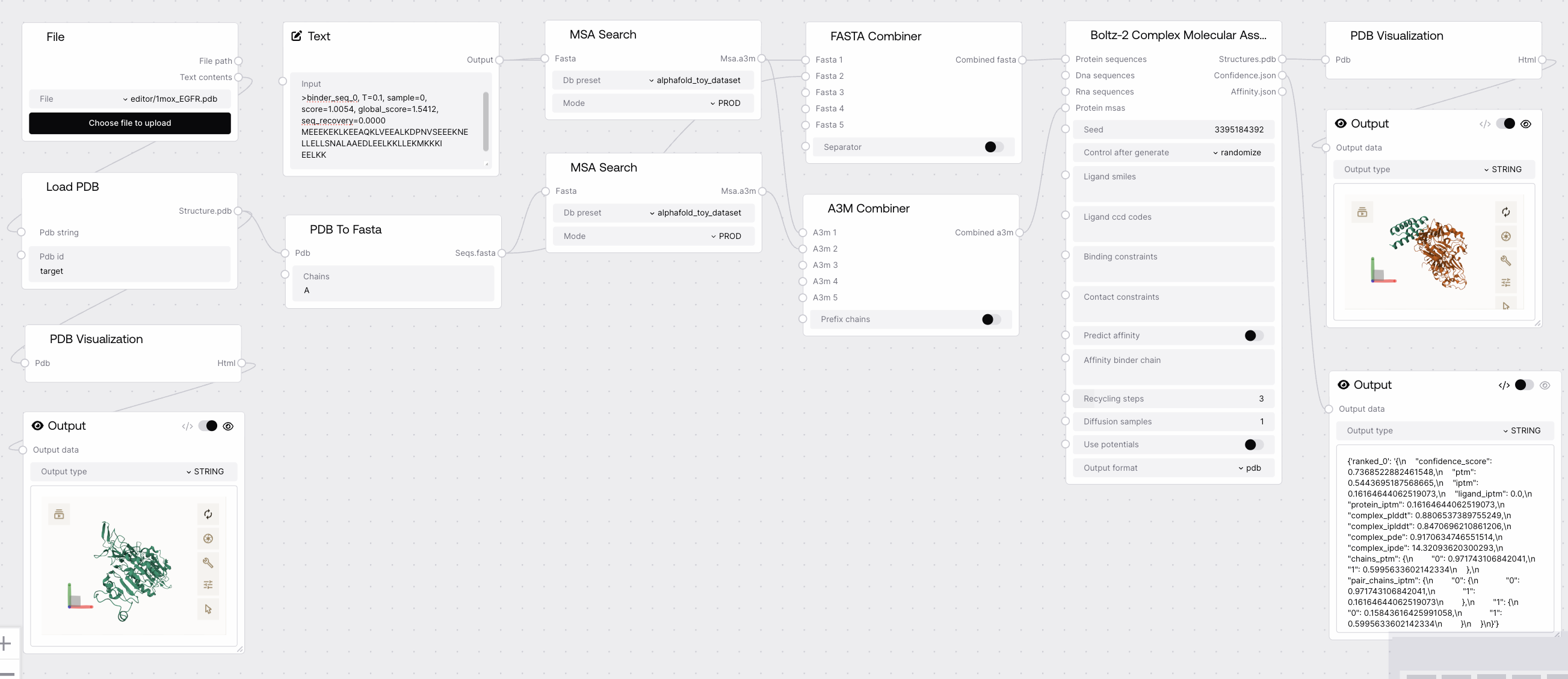Boltz-2 Complex Molecular Assembly
Boltz-2 Complex Molecular Assembly enables the joint prediction and assembly of multi-component biomolecular complexes, including proteins, DNA, RNA, and ligands, with optional constraints and affinity prediction.

Quick Start
- Prepare FASTA sequences for each molecular component (protein, DNA, RNA) as needed.
- (Optional) Provide ligand SMILES or CCD codes, and custom MSAs for proteins.
- (Optional) Specify binding or contact constraints.
- Set prediction parameters (e.g., recycling steps, diffusion samples).
- Run the node to generate assembled complex structures and confidence/affinity scores.
Setup Guide
- Collect and format protein, DNA, RNA sequences in FASTA format.
- List ligand SMILES or CCD codes (one per line).
- (Optional) Prepare A3M MSAs for proteins.
- (Optional) Define binding or contact constraints as described in the node UI.
- (Optional) Enable affinity prediction and specify binder chain if needed.
- Adjust prediction parameters (recycling steps, diffusion samples, etc.).
Basic Usage
Multi-Component Assembly
- Assemble complexes from any combination of proteins, DNA, RNA, and ligands.
- Optionally provide MSAs for improved protein modeling.
- Apply binding/contact constraints to guide assembly.
- Predict binding affinity for ligand-containing complexes.
Configuration
| Field |
Description |
Type |
Example |
| seed |
Random seed for reproducibility |
INT |
42 |
| Field |
Description |
Type |
Example |
| protein_sequences |
Protein sequences in FASTA format |
FASTA |
>A\nMKVL...\n>B\nGYLL... |
| dna_sequences |
DNA sequences in FASTA format |
FASTA |
>DNA1\nATCG... |
| rna_sequences |
RNA sequences in FASTA format |
FASTA |
>RNA1\nAUCGA... |
| ligand_smiles |
Ligand SMILES strings (one per line) |
STRING |
CCO\nCC(=O)O |
| ligand_ccd_codes |
Ligand CCD codes (one per line) |
STRING |
ATP\nGTP |
| protein_msas |
Custom MSAs for proteins |
A3M |
{"A": "..."} |
| binding_constraints |
Binding constraints (see UI) |
STRING |
A:B:10,20 |
| contact_constraints |
Contact constraints (see UI) |
STRING |
A:10-B:20 |
| predict_affinity |
Enable binding affinity prediction |
BOOLEAN |
True |
| affinity_binder_chain |
Chain ID for affinity calculation |
STRING |
L1 |
| recycling_steps |
Number of recycling iterations |
INT |
3 |
| diffusion_samples |
Number of structure samples |
INT |
1 |
| use_potentials |
Use potentials for improved accuracy |
BOOLEAN |
False |
| output_format |
Output file format |
COMBO |
pdb |
Outputs
| Field |
Description |
Example |
| structures.pdb |
Assembled complex structures (ranked) |
{"A": "...PDB..."} |
| confidence.json |
Confidence scores for predictions |
{"A": 0.92} |
| affinity.json |
Binding affinity scores (if enabled) |
{"A": -7.5} |
Best Practices
- Provide high-quality, correctly formatted FASTA sequences for all components.
- Supply MSAs for proteins when possible to improve structure accuracy.
Constraints & Affinity
- Use binding/contact constraints to guide specific interactions.
- Enable affinity prediction only when ligands are present and specify the correct binder chain.
Troubleshooting
Common Issues
- Missing molecular components: At least one protein, DNA, RNA, or ligand must be provided.
- MSA not provided: Results may be lower quality for proteins without MSAs.
- Affinity prediction error: Ensure at least one ligand is present and binder chain is specified or auto-detectable.
Need Help?
- Contact support for further assistance.
